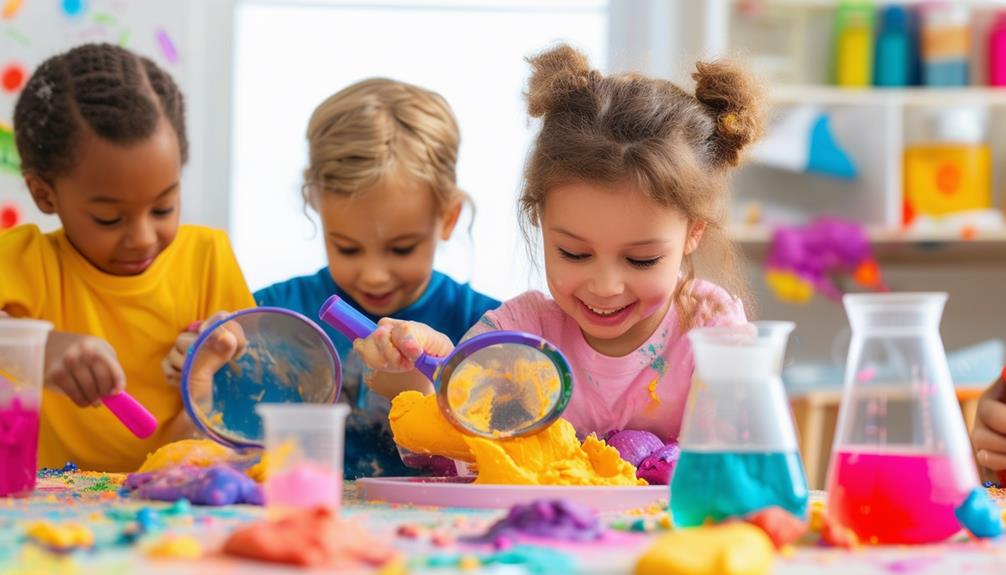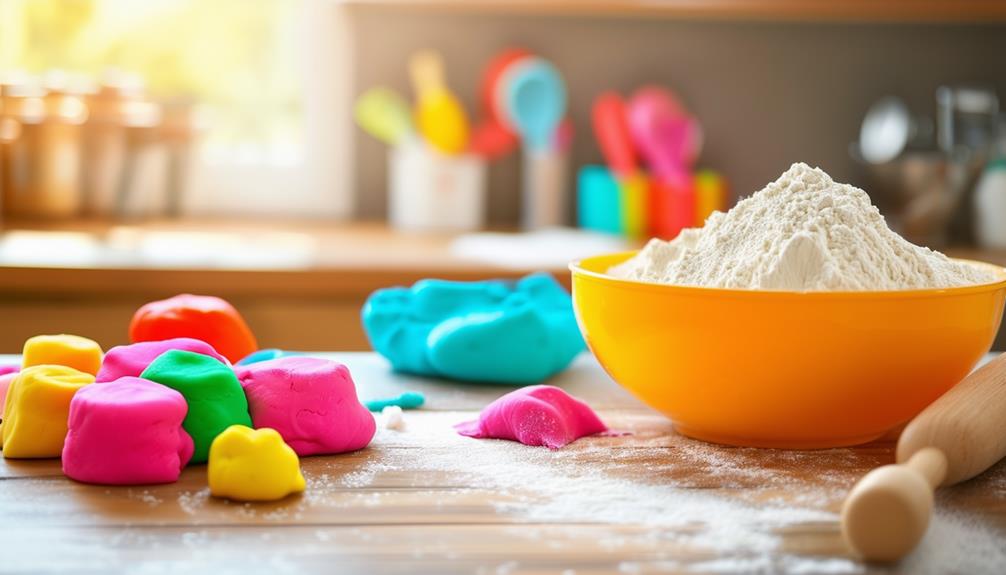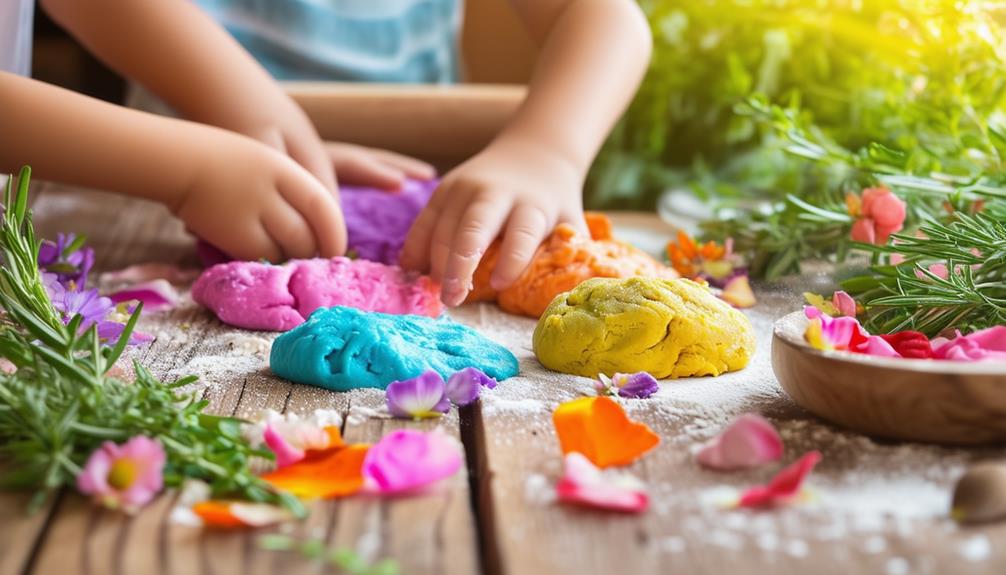The Science Behind Playdough: What Makes It Work?

Have you ever wondered what makes playdough so distinctively pliable? The science behind playdough involves a precise blend of ingredients and fascinating chemical reactions. Flour and water form gluten, giving it structure, while salt enhances texture and acts as a preservative. Adding a bit of vegetable oil results in a smooth, non-drying consistency. The magic lies in how these elements interact, transforming simple kitchen staples into a versatile, engaging material. Curious about the intricate role salt plays in this process?
Essential Ingredients
To make playdough, you'll need flour, salt, vegetable oil, and water. Each ingredient plays a vital role in creating the perfect, moldable dough. When you mix flour and water, the proteins in the flour form gluten, giving the dough its structure and elasticity. Without enough water, the dough would be too dry and crumbly; too much water makes it a sticky mess. Salt does more than just season; it helps the proteins bond, enhancing the playdough's texture. Additionally, salt acts as a preservative, extending the dough's shelf life.
Vegetable oil is crucial for preventing the dough from drying out. It adds a smooth consistency, making the playdough easier to knead and shape. The oil coats the flour particles, helping to maintain moisture over time.
Understanding the roles of flour, salt, vegetable oil, and water ensures you achieve the right texture and elasticity for fun, creative play. Precise measurements of each ingredient are key to making high-quality playdough.
Step-by-Step Guide
Start by gathering all your ingredients and kitchen tools to ensure you have everything needed before you begin. You'll need flour, salt, vegetable oil, cream of tartar, boiling water, and food coloring. Begin by mixing the dry ingredients in a large bowl: flour, salt, and cream of tartar. The table below summarizes these necessary items:
| Ingredient | Quantity |
|---|---|
| Flour | 2 cups |
| Salt | 1 cup |
| Cream of Tartar | 2 tablespoons |
Once your dry mix is ready, heat water until it boils and add your desired food coloring. Slowly pour the colored water into the dry mixture while stirring continuously. This step is crucial for ensuring the ingredients mix well and trigger the necessary chemical reaction to form playdough.
| Kitchen Tool | Purpose |
|---|---|
| Large Mixing Bowl | Combine ingredients |
| Wooden Spoon | Stir the mixture |
| Measuring Cups | Accurately measure |
Keep stirring until the dough starts to come together. If it's too sticky, add more flour; if it's too dry, add more water. Adjusting these levels allows customization of the playdough's consistency. Once mixed, knead the dough on a flat surface until it's smooth and pliable. Enjoy your homemade playdough, understanding the science behind its creation!
Chemical Reactions

Mixing water and flour causes the proteins to clump together, giving playdough its sticky texture. Salt is crucial as it binds these proteins, forming a cohesive dough. This interaction results in a chemical reaction that transforms the individual ingredients into a versatile new substance.
Protein Clumping Process
Adding water to flour in playdough causes the proteins to clump together, changing its consistency. This clumping process is crucial for turning the mixture from a powdery substance into a stretchy, moldable dough. When water is mixed with flour, the proteins, primarily glutenin and gliadin, interact to form a network called gluten. This network imparts the unique texture and elasticity to playdough.
Here's a brief overview of the protein clumping process:
- Water Activation: Adding water activates the proteins in the flour, prompting them to bond.
- Protein Network Formation: The activated proteins link to form a stretchy network, giving the dough its elasticity.
- Consistency Change: Kneading the dough strengthens this network, transforming it from crumbly to smooth.
- Tactile Properties: This network makes playdough enjoyable to touch, stretch, and mold.
Understanding this process explains why playdough behaves as it does. It's not merely about mixing ingredients; it's about triggering a chemical reaction that transforms the components into a new, enjoyable substance.
Salt's Role Explained
Have you ever wondered how salt improves the structure and flexibility of playdough? When you add salt to playdough, it helps the proteins in the flour bond together, creating a sturdy framework. This structure is essential because it gives the dough its form and prevents it from falling apart. The salt facilitates a chemical reaction that enhances the dough's flexibility, making it more pliable and easier to shape.
Salt acts as a bonding agent, allowing the playdough to maintain its shape and resist crumbling. This is why you can mold it into various shapes without it breaking apart easily. Additionally, the presence of salt contributes to the playdough's characteristic salty aroma, which is quite unique.
Ingredient Transformation
Understanding salt's role in playdough sets the stage for exploring how each ingredient transforms through chemical reactions. When you add water to flour, the proteins in the flour undergo a crucial change. They clump together, forming a sticky mixture essential for the dough's texture. Salt enhances this process by helping the proteins bond more effectively, creating a strong structure for the dough.
The transformation begins when you mix the ingredients. Here's how it unfolds:
- Water Activation: Water hydrates the flour, allowing proteins to clump together.
- Salt's Role: Salt aids in binding these proteins, giving the dough its firmness.
- Chemical Reaction: Mixing the ingredients initiates a chemical reaction that transforms individual components into a cohesive, pliable substance.
- Characteristic Smell: The distinct smell of store-bought playdough often originates from the salt in the mixture.
This comprehensive understanding ensures the process is both effective and reliable.
Role of Salt
Salt plays a crucial role in giving playdough its unique elasticity and texture. When added to playdough, salt acts as a binding agent, helping the proteins in the flour to stick together. This creates a matrix around the flour particles, providing the necessary structure that makes playdough moldable and fun to shape.
The distinct salty smell of store-bought playdough is a result of its salt content. However, salt's contribution goes beyond just the aroma. It is essential in forming the final dough product by participating in a chemical reaction that enhances the playdough's texture and elasticity.
Without salt, playdough would lack the same pliability and would likely fall apart more easily. So, the next time you play with or make playdough, remember that salt is a key ingredient ensuring the playdough remains stretchy and durable for hours of creative fun.
Playdough Consistency
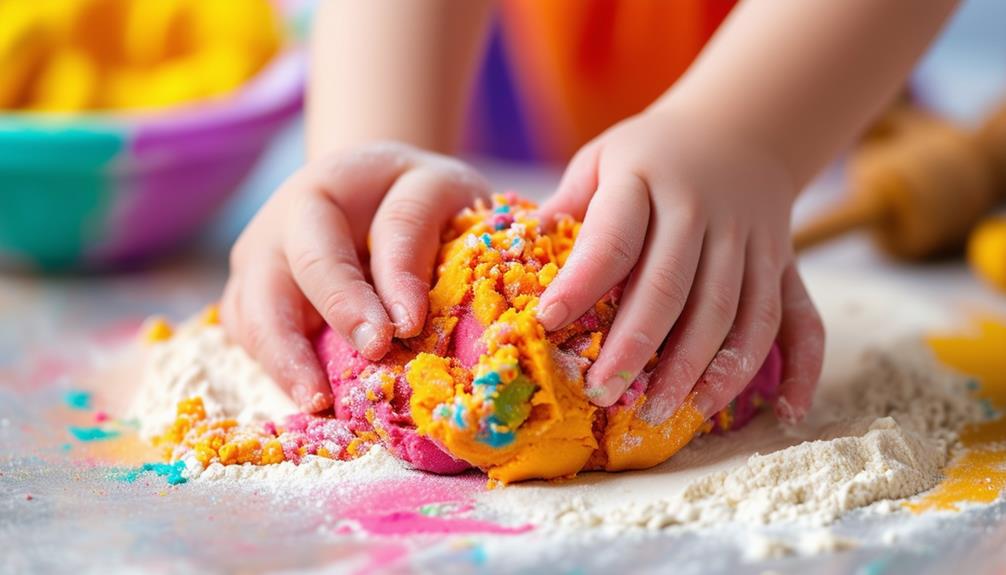
Achieving the ideal playdough consistency involves balancing flour, water, salt, and oil. This can be a bit of a science, but the effort is worth it for a smooth, pliable texture. Too much water will create a sticky mess, while too much flour will make the playdough dry and crumbly. Follow these tips to find the perfect balance:
- Proper Proportions: Start with equal parts flour and water, and adjust as needed.
- Mix and Knead: Thoroughly mix and knead the ingredients to ensure a smooth texture.
- Elasticity Enhancers: Add a bit of cream of tartar or lemon juice to improve elasticity.
- Gradual Adjustments: Add small amounts of water or flour gradually to fine-tune the consistency.
Sensory Benefits
Playdough provides a comprehensive sensory experience that engages touch, smell, and sight, enhancing sensory development in children. When kids knead and shape playdough, they refine their fine motor skills and improve hand-eye coordination. The tactile feedback from the dough educates them about texture and pressure, promoting relaxation and stress relief. Additionally, the variety of colors and scents in playdough sparks creativity and imagination, making playtime both engaging and educational.
Children explore and understand the world through these sensory activities. The following table outlines the sensory benefits of playdough:
| Sensory Aspect | Benefit | How Children Learn |
|---|---|---|
| Touch | Enhances fine motor skills | By kneading and shaping |
| Sight | Fosters creativity and imagination | Through observing colors and shapes |
| Smell | Promotes relaxation | By using scented playdough |
| Texture | Provides a calming experience | Through feeling the dough |
| Pressure | Aids hand-eye coordination | By molding and pressing |
As children manipulate playdough, they not only develop physical skills but also explore various sensory inputs, building a solid foundation for learning and development. Engaging in these tactile experiences allows children to express themselves creatively while receiving valuable sensory feedback.
Creative Uses
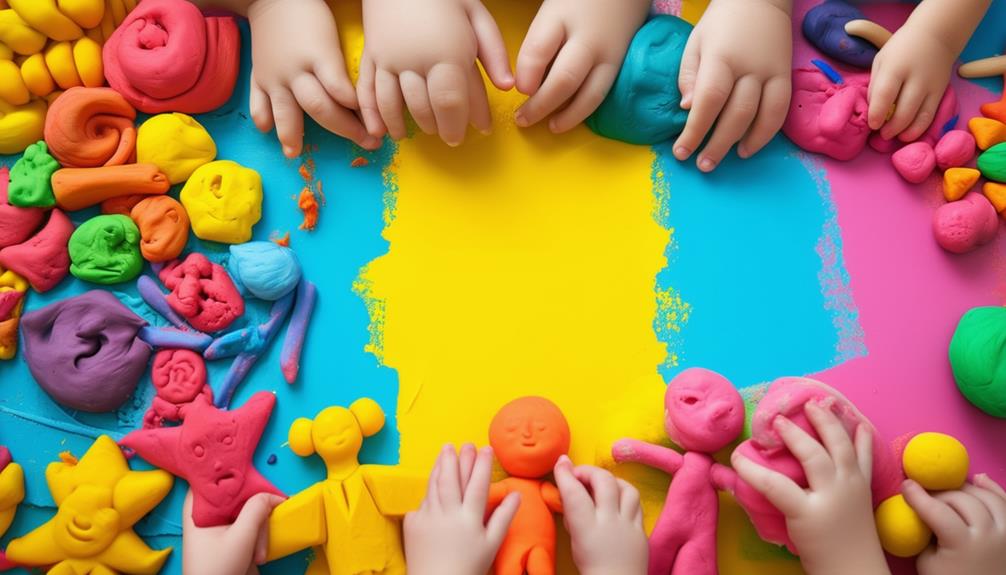
Explore endless creative possibilities with playdough by experimenting with color mixing, crafting unique shapes, and engaging in sensory play. These activities not only enhance creativity but also develop various skills. Let's delve into how these methods can make playdough even more exciting and educational.
Color Mixing Techniques
By blending primary colors such as red and blue, you can create secondary colors like purple in your playdough projects. Experimenting with different proportions of these colors allows you to achieve various shades and tones, adding depth to your creations. Overlaying different colors can result in unique patterns and designs when you roll or shape your playdough.
To make your playdough projects more captivating, consider incorporating glitter or metallic powders. These additions can give your creations a shimmering effect that attracts attention. Using contrasting colors is another method to make your playdough designs visually striking and appealing.
Here are four techniques to enhance your color mixing skills:
- Gradients: Gradually blend two colors to create a smooth transition from one hue to another.
- Marbling: Twist and fold different colors of playdough together to achieve a marbled effect.
- Layering: Stack different colors in layers, then roll or press them to form intricate patterns.
- Tinting: Mix small amounts of white playdough with your colors to create lighter, pastel shades.
Experimenting with these techniques can elevate your playdough projects to a new artistic level!
Unique Shape Creations
Using a variety of tools and techniques, you can sculpt playdough into intricate shapes like animals, buildings, and vehicles, enhancing both creativity and fine motor skills. With simple ingredients such as flour, water, salt, and food coloring, playdough becomes a versatile medium for artistic expression. Imagine crafting scales on a dragon or delicate petals on a flower—these detailed designs not only enhance your creativity but also improve your hand-eye coordination and dexterity.
You can use cookie cutters, rolling pins, and sculpting tools to explore different textures and patterns. These tools help you experiment with 3D modeling, allowing you to better understand spatial awareness and geometric concepts. For instance, rolling a flat sheet of playdough and cutting out shapes teaches you about symmetry and proportions.
Additionally, by blending colors and mixing techniques, you can create beautiful gradients and delve into color theory. Combining different shades of playdough helps you see how primary colors mix to form secondary ones, adding another layer of learning to your play. Each time you engage with playdough, you're not just having fun; you're also developing essential cognitive and motor skills using simple, everyday ingredients.
Sensory Play Ideas
Incorporating sensory play with playdough engages multiple senses, making it a rich and therapeutic activity for both children and adults. Here are some sensory play ideas to explore:
- Infuse Scents: Add scents like vanilla, lavender, or peppermint to playdough to stimulate the sense of smell. This can make the activity more enjoyable and calming.
- Texture Exploration: Mix in textured items such as beads, rice, or small pasta pieces. This enhances the tactile experience and helps develop fine motor skills.
- Color Mixing: Encourage mixing different colored playdoughs. This visual activity improves hand-eye coordination and introduces basic color theory.
- Emotional Regulation: Use playdough as a stress-relief tool by kneading, squeezing, and molding it. This repetitive action can be soothing and help regulate emotions.
Playdough Variations
Explore a world of creativity with various playdough types, each offering unique sensory and visual experiences. Scented playdough, infused with essential oils, can be particularly engaging for children by introducing them to new smells and enriching their sensory adventure. Imagine the delight on their faces as they shape lavender-scented dough or create forms with a hint of peppermint in the air.
Another exciting variation is glitter playdough, which adds sparkle and texture to children's creations, making playtime more visually stimulating. Kids can craft shimmering stars, sparkly castles, or gleaming animals, while also developing their fine motor skills.
Edible playdough, made with food-grade ingredients, provides a safe way for children to explore taste. This is especially beneficial for younger kids who tend to put things in their mouths. Parents can relax, knowing their children are safe as they shape and taste their colorful, enjoyable creations.
Glow-in-the-dark playdough, containing phosphorescent materials, offers an exciting twist. Watch as their creations illuminate in the dark, adding an element of magic to their playtime. Lastly, thermochromic playdough changes color with temperature variations, adding a dynamic and educational element to their play. Children can learn about temperature while having fun!
STEM Learning

Playdough is a versatile tool for introducing young children to STEM concepts through engaging, hands-on activities. It allows kids to explore textures, materials, and cause-and-effect relationships, laying the groundwork for scientific thinking. These early STEM experiences help children develop observation skills and enhance their mathematical thinking and problem-solving abilities.
Here are four ways playdough promotes STEM learning:
- Investigating Properties of Matter: Children learn about states of matter by observing how playdough changes shape and texture when manipulated.
- Understanding Cause and Effect: Mixing different colors or adding elements like glitter demonstrates material interactions and changes, fostering an understanding of cause-and-effect relationships.
- Building Mathematical Skills: Measuring ingredients to make playdough or using tools to cut shapes helps children grasp concepts like volume, geometry, and symmetry.
- Encouraging Scientific Observation: As children experiment with playdough, they make observations and predictions, following the scientific method.
Safety Tips
When making playdough, always supervise children to ensure they handle ingredients safely. Exercise caution with boiling water during the mixing process and remind children not to ingest any of the raw ingredients. Clear communication about these safety measures can prevent accidents, ensuring a fun and educational experience.
Supervise During Mixing
Always supervise children closely during playdough mixing to prevent any accidental ingestion of harmful ingredients. Mixing playdough can be a fun and educational activity, but ensuring safety is vital. By working together, you can make this process both safe and enjoyable.
Here are some essential safety tips to keep in mind:
- Wear Safety Goggles: Protect your children's eyes from potential splashes of ingredients. Safety goggles are a simple yet effective way to prevent accidents.
- Clear Communication: Before starting, discuss the importance of safety measures with your children. Make sure they understand why they shouldn't taste or touch certain ingredients.
- Monitor Ingredient Use: Ingredients like salt can be harmful if ingested in large quantities. Keep these materials out of reach when not in use and only allow supervised handling.
- Follow the Recipe: Proper supervision ensures that children follow the recipe correctly, avoiding any potential hazards. This also teaches them to adhere to guidelines for a successful outcome.
Handle Boiling Water Carefully
Handling boiling water with care is critical to prevent burns and ensure a safe playdough-making experience. The high temperature of boiling water can cause severe injuries if spilled or splashed, so always prioritize safety. When working with boiling water, use oven mitts or long-handled utensils to protect yourself. It is also vital to keep children away from boiling water and supervise them closely to prevent accidents.
Always pour boiling water slowly and carefully to avoid splashing and burns. Being mindful of your actions can make all the difference. Here's a quick guide to underscore the importance of handling boiling water carefully:
| Emotion | Safety Tip |
|---|---|
| Fear of burns | Use oven mitts or long-handled utensils. |
| Concern for kids | Keep children away from boiling water. |
| Relief from worry | Supervise children closely during the process. |
| Avoidance of pain | Pour boiling water slowly and carefully. |
| Peace of mind | Always prioritize safety when boiling water. |
Avoid Ingesting Ingredients
Because playdough ingredients like salt and cream of tartar can pose health risks if ingested, it is crucial to handle them with care and ensure children understand these dangers. Educating kids about why they should avoid ingesting playdough ingredients is essential. Here are some practical steps to ensure safety:
- Supervise Playtime: Always monitor children while they play with playdough to quickly intervene if they attempt to eat it.
- Educate on Dangers: Explain in simple terms that certain ingredients, like salt and cream of tartar, can make them sick if ingested.
- Set Clear Rules: Establish and consistently enforce rules against putting playdough or its ingredients in their mouths. Remind them of these rules each time they play.
- Use Safety Gear: When making playdough, wear safety goggles and avoid contact with eyes to reduce the risk of accidental ingestion or irritation.

